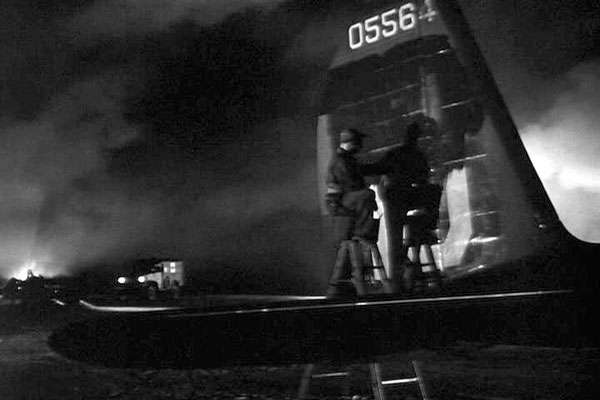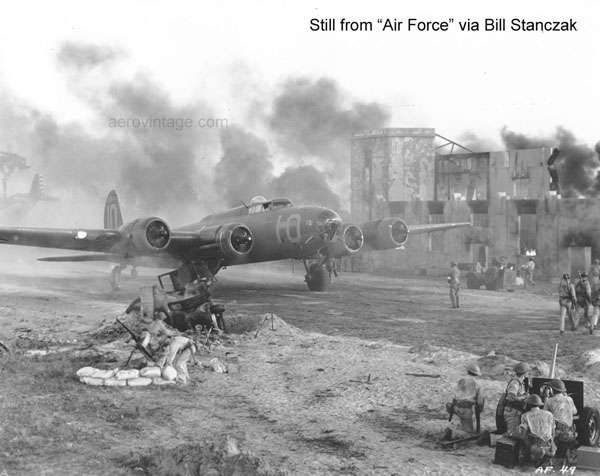| Title | Air Force |
| Studio | Warner Brothers |
| Date Released | February 3, 1943 |
| Director | Howard Hawks |
| Actors | John Ridgely, Gig Young, John Garfield, Arthur Kennedy, Harry Carey |
| Airplane Filming Guys | Paul Mantz, Paul Gustine, Harry Crosby, Elmer Dyer, Charles A. Marshall |
| B-17 Filming Locations | Drew Army Air Field, Tampa, Florida |
B-17s Utilized
B-17B 38-211 (#18)
B-17B 38-261 (#07)
B-17B 38-584 (#10) as Mary Ann, fictional B-17D 40-5564
B-17B 39-001 (#15)
plus approximately five other unidentified B-17B, B-17C, and/or B-17Ds
The Movie...
Air Force was an early war production that stands above the similar efforts of the time, films such as Flying Tigers. It is a fictional account of a B-17 crew that is loosly based on the early months of the war. It depicts a group of B-17s departing Hamilton Field, California, on December 6, 1941, and flying right into the attack on Pearl Harbor, something that actually happened. The primary screenwriter, Dudly Nichols, was provided access to combat records for the 19th Bomb Group and exploits from that group were used as the basis of the movie.
The crew of the B-17, named the Mary Ann, then flies their bomber on to the Philippines via Wake Island. Once at Clark Field, the crew prepares for combat, but on the first mission flown the airplane is damaged, makes a belly landing, and the aircraft commander killed. As Clark Field is being evacuated, the Army orders the grounded Mary Ann burnt to avoid it falling into enemy hands. The crew struggles valiantly to protect and repair the airplane to fly it out, rather than see it destroyed. The climatic scene shows dramatic effort to fly the airplane out. Soon afterwords, the airplane crew locates a large Japanese fleet, and the Mary Ann sticks around long enough to radio its location. Soon the entire Army and Naval air forces are called in and they send the invaders to the bottom of the ocean.
There are a few peculiarites that stand out now, sixty-years later. One is the way the screenwriters go out of their way to state that Japanese nationals in Hawaii aided the Pearl Harbor attackers, and that sabotage was committed by trucks running the flight line and destroying rows of P-40. There were also depicted Japanese guerrillas in the jungles of Maui attacking the Mary Ann parked on a remote airfield. By May 1942 those accounts had been thoroughly discounted so why include them in the film? Also, the massive attack at the end of the film, in which the U.S. finally repays for Pearl Harbor, is overdone and almost ruins the film, at least for this 21st Century viewer. However, for the wartime audience that the film was aimed at, it no doubt provided hope for the eventual victory.
The film features some above-average model work, particularly depicting the Mary Ann coming in on a landing approach and snagging a fence. Some of the model-depicted landings are a little "rough" but overall they are a cut above other films of the same era. By the way, most of the scenes depicting the destruction of the Japanese Navy at the end of the film were also minatures shot in the ocean near Santa Barabara, California.
Also of note is the attention to detail for the scenes depicting the B-17 operations. Excellent interior shots, scenes of engine starts, crew interaction, and film continuity mark the film. The scenes where the crew is trying to start the number two engine with others pouring gas on the wheels to get the airplane to burn, all while the Japanese are attacking the field, are particularly good.
Note that this film was released as a DVD in June 2007 so it can be viewed in excellent video and audio quality. Extra features are a bit sparse, limited to two wartime cartoons, a radio interview, and the theatrical trailer. But that's not too important as the film is now available for purchase on DVD.
Anecdotal
- The operational scenes were filmed in late July and August 1942 while based at Drew AAF, near Tampa Bay in Florida. Elements of the Combat Crew Training Center equipped with early B-17s that was based at Hendrick Field, Sebring, Florida, were used. Several P-39s and P-43s drawn from Drew Field were also used. T-6s also are used to depict Japanese fighters and an American dive bomber (A-25?).
- Bruce Orriss' account in When Hollywood Ruled the Skies reveals that the cockpit mockup used in the film was originally constructed for Paramount's 1938 I Wanted Wings. There were numerous interior shots of the B-17 in the film that appear to be quite accurate.
- The serial number shown for the starring B-17, the Mary Ann was 40-5564, a fictional number. This airplane remains unidentified but it is pretty conclusive that it was a B-17B that had been brought up to B-17C/D standards with fuselage and armament modifications, probably done by Boeing to many B-17Bs. A case can be made that the B-17B used was 38-583, but this is conjecture based upon serial number manipulation. 38-583 appears to have been assigned to Sebring from June through September 1942, though the record card indicates possible assignment to the Subdepot at Lowry Field, Colorado, during this period also.
- Bruce Orriss tells that the scenes depicting the destruction at Hickam, Wake Island, and Clark Field, were shot adjacent to Drew AAF.
- Production commenced on May 18, 1942 and wrapped on October 26, 1942. The movie was released on February 3, 1943, to good reviews. It was nominated for two Oscars and won one.
- In the movie Air Force, when they cut the tail off and install a gun back there, Gig Young asks John Garfield if he has enough room. He replies, "Yeah, if you leave the tail wheel down." This is true. However, there is only 7" of space between the fuselage bottom and the bottom horizontal stab carry through spar at BLK #10. This little bit of information courtesy of Bill Stanczak.
Buy this Movie!
Links
Acknowledgements
- Dan Katz for much original research on the film, including B-17B identities
- "When Hollywood Ruled the Skies" by Bruce W. Orriss
- Bill Stanczak for pulling the video screen shots

A still from the film showing the Mary Ann as it arrives at Hickam Field after the attack on Pearl Harbor. It is believed this and other similar scenes were shot near Tampa Bay, Florida, though the exact location is unknown.
After the film was completed, the AAF used B-17B 38-584 that starred as the Mary Ann in a war effort publicity tour. This photo shows in detail the reason that this B-17, often misidentified as a B-17C, was actaully the earlier variant upgraded to a B-17C configuration. The location of the oil cooler scoops and cowling arrangement indicate those of a B-17B.
One of many great air-to-air shots of the small-tail B-17s that are sprinkled throught the film. This view shows the Mary Ann in flight. Note the missing tail cone, which ties into the below scene where it was removed to add a tail gun. This was one of many little 'attention to detail' items that were missing in similar films of the era.

To add a tail gun to the B-17B, the tail cone is shown being sawn off and replaced by a .50 caliber machine gun. That's John Garfield as the new tail gunner. I guess by this point in the war the wartime censors figured the Japanese knew these B-17s didn't have tail guns but didn't know how many B-17s we had, thus the fictional tail number on the Mary Ann.

Unusual in this film is that the B-17s actually drop bombs, and it sure looks like real anti-aircraft fire in these scenes. Either it was unually good trick photography or some very trusting Air Corps pilot was promised that they wouldn't really aim at him when they shot the scene.

The big "10" on the tail gets painted out in this scene in the film as the Mary Ann s prepared for combat. The tail number represents an AAF serial of 40-5564, not a valid serial for any aircraft. The filmakers went to great pains to show this airplane as having this serial number, including the film credits that listed the crew of "B-17 Plane Number 05564" and a navigator's log that showed the airplane as a B-17D with this serial. It turns out this airplane is actually B-17B 38-584.

One of the early ground shots in the film showing a pensive John Ridgely walking the flight line. A squadron of early B-17s used for flight training were employed in the production, shot in July and August 1942 just after the Battle of Midway. The overwhelming Allied victory at the end of the film, though, resembles the Battle of the Coral Sea of May 1942.

For those who enjoy seeing the early B-17s in action, Air Force is full of operational scenes of these airplanes. This scene shows the Mary Ann upon landing at Clark Field in the Philippines, though it is actually somewhere in Florida. The B-17B is dragging a fence after a short field landing, a nice touch, as are the squealing brakes noted as the airplane taxis by.

This is, at least to my eye, one of the few identifiable B-17 in the film, B-17B 39-001, in a takeoff scene. Note how the serial is only painted on the rudder and not the vertical stabilizer, a practice verified on photos of other early B-17s but not on the modified serial of the Mary Ann.

You'll never see the likes of this again: nine B-17Bs, Cs, and Ds in a mixed formation, probably shot offshore near Florida by Paul Mantz and Elmer Dyer. The camera platform used for this show is unknown, but may have been one of Mantz's special camera ships. Bruce Orriss notes that Mantz's Lockheed Orion, Beoing 100, and Stinson were all used for the filming. This scene depicts the flight from California to Hawaii early in the film.


